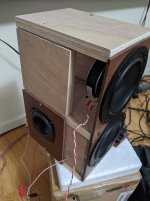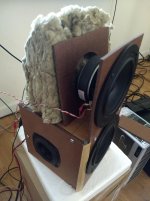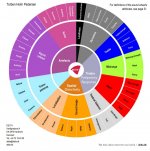6dB decrease is 1/2 amplitude, correct?
Correct. On a pure measurement basis. But on a perception basis it takes about 10db difference for you to think of it as 1/2 the sound level.
In any case, it's still there. Not gone. You will hear something.
classicalfan> how can you look at that plot and see a modest improvement? You seem to only want to recognize a narrow band peak as "only" 6 dB down, what about the much wider band of resonances that are down 15 dB now? I'm sorry but you are seeing what you want to see, not what most unbiased observers would see in the data.
I guess I am being somewhat of a devil's advocate here. But that is not to diminish all the hard work and testing you have done. It is very impressive.
It just seems to me that putting drivers in boxes can cause more problems than it solves. And the work-arounds by building even more complex and expensive boxes seems to be going even further in the wrong direction.
That's just my opinion and I'm sure it's not shared by all of the posters here. Or probably even most of them.
Last edited:
An impedance measurement will be easier and as useful (if not, more useful; imagine you measure the cabinet in the "wrong" spot).
You can verify resonances with a CSD if you wish.
For example, a recent loudspeaker test I conducted shows a cabinet resonance ~120Hz:
Klipsch Heresy IV Speaker Review
You can see this in the impedance and the CSD backs this up:
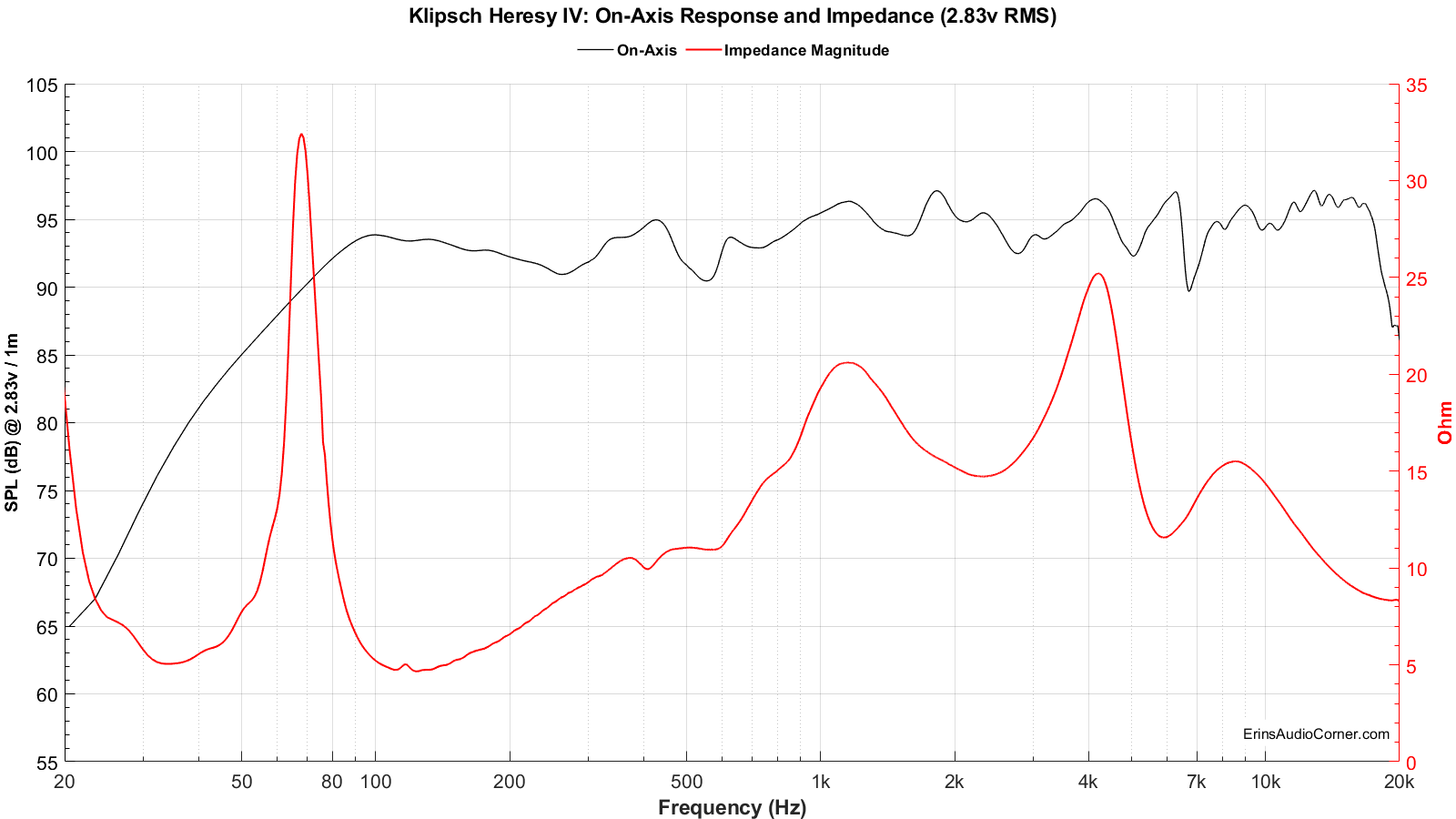
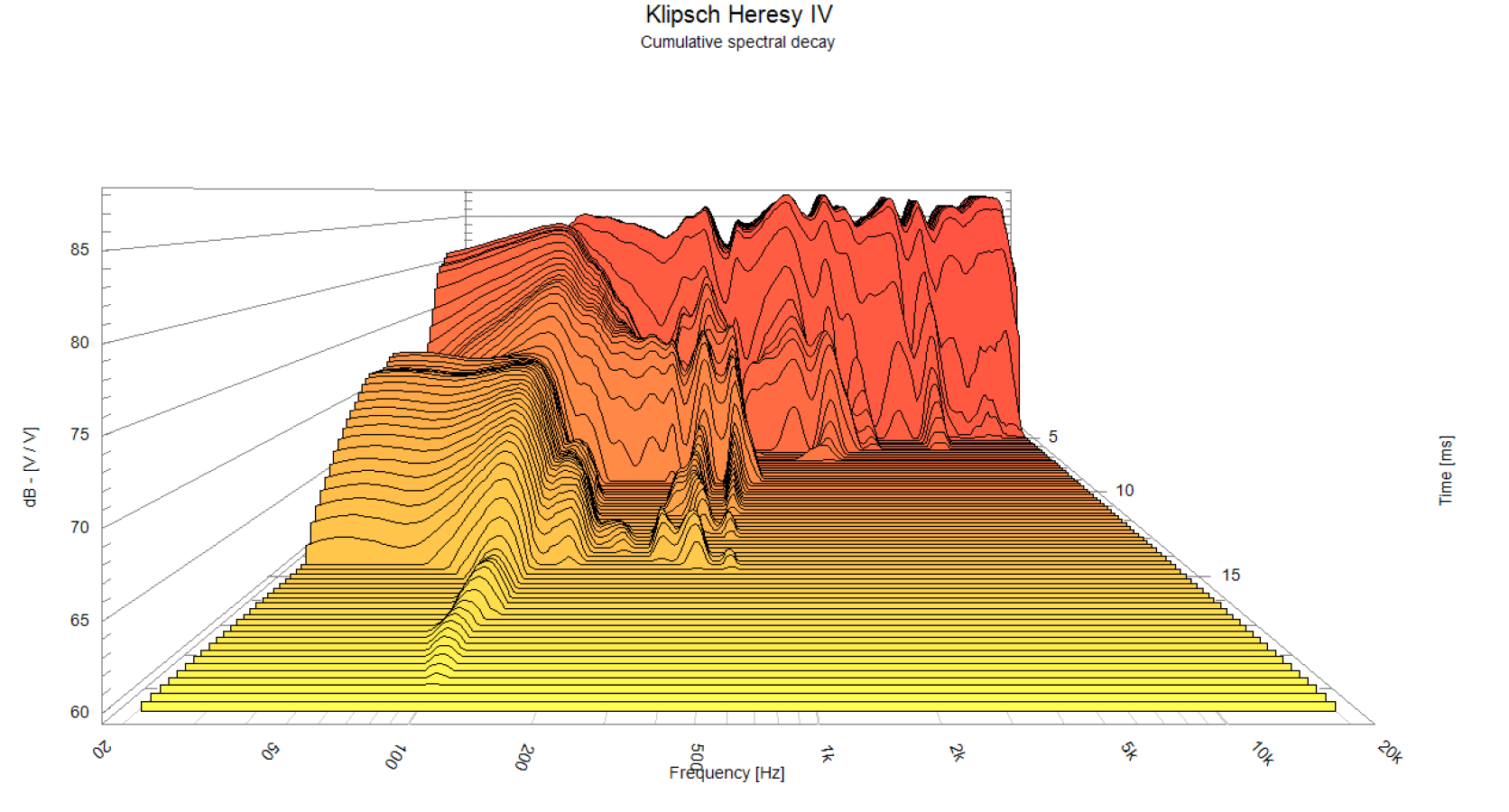
You can verify resonances with a CSD if you wish.
For example, a recent loudspeaker test I conducted shows a cabinet resonance ~120Hz:
Klipsch Heresy IV Speaker Review
You can see this in the impedance and the CSD backs this up:


classicalfan> I'm not putting forth those results as being any great idea by myself, so I don't have any horse in the race whether they perform well or not. I just wanted to find out what works. Bracing quite obviously does. Is it enough? Well we can debate that and certainly I'm looking to improve on those baseline results, but to say bracing does nothing but shift frequency just is not born out my measurements or others I've seen. I'm not sure what the contect of Linkwitz's tests were. Was he bracing an open baffle? Not at all the same thing as a box.
bikinpunk> I wouldn't call that cabinet resonance, but pipe resonance of the air in the cabinet.
bikinpunk> I wouldn't call that cabinet resonance, but pipe resonance of the air in the cabinet.
augerpro> NF measurement of the port (I assume this is what you mean by pipe resonance?) shows turbulence a couple octaves up between 400-600Hz (the impedance shows this as well). But no port resonance in the region I mentioned above.
If you mean standing waves inside the enclosure, that's what I mean... the inside of the enclosure is resonating, thus driving vibration at the panels. And, while I have the data, I can tell you there was audible resonance from lower male vocals during my subjective evaluation (performed well before the speaker was measured objectively) and I estimated it to be in the 150Hz region. The data showed what I was hearing.
If you mean standing waves inside the enclosure, that's what I mean... the inside of the enclosure is resonating, thus driving vibration at the panels. And, while I have the data, I can tell you there was audible resonance from lower male vocals during my subjective evaluation (performed well before the speaker was measured objectively) and I estimated it to be in the 150Hz region. The data showed what I was hearing.
Last edited:
It just seems to me that putting drivers in boxes can cause more problems than it solves.
It's yet to be shown the problems aren't exaggerated. People can't even agree what boxy sound is, let alone what causes it, there was a thread recently.
If you mean standing waves inside the enclosure, that's what I mean... the inside of the enclosure is resonating, thus driving vibration at the panels.
I separate the standing wave resonance of the air mass from the cabinet wall resonances, and I think this thread is more focused on the latter was what I was pointing out.
Scott,
There is not much dispute that the box adds a sound not there in the music. Whether people agree on what it sounds like is not that important. Something has been added. And whether it's objectionable or not is really a matter of personal preference. Some may actually like it, others may not. But to the purest, nothing extra should be present in the music.
There is not much dispute that the box adds a sound not there in the music. Whether people agree on what it sounds like is not that important. Something has been added. And whether it's objectionable or not is really a matter of personal preference. Some may actually like it, others may not. But to the purest, nothing extra should be present in the music.
Last edited:
I built a low-mid box with one driver boxed and one open + a removable cardioid box.
Both drivers have the same frequency response curve controlled with DSP and measured with REW yet they sound different. As I add stuffing (mineral wool) behind the open driver they begin to sound more similar.
My hunch is that the box sound is just a type of directivity. If your ear is close to the driver they both sound the same. Get out into room reflections and they sound different.
That's just my hunch not fact.
Both drivers have the same frequency response curve controlled with DSP and measured with REW yet they sound different. As I add stuffing (mineral wool) behind the open driver they begin to sound more similar.
My hunch is that the box sound is just a type of directivity. If your ear is close to the driver they both sound the same. Get out into room reflections and they sound different.
That's just my hunch not fact.
Attachments
My hunch is that the box sound is just a type of directivity. If your ear is close to the driver they both sound the same. Get out into room reflections and they sound different.
Yes, power response is probably part of it.
bradleypnw, I agree about directivity, an unusual effect of listening to my box in a box speakers is that they sound just as loud on the other side of the room as they do close up, I presume it's because with normal speakers when far away you hear far more room reflections from vibrating panels ( thus blurring the sound, making it seem indistinct and quieter )but with much reduced cabinet vibration you still hear a higher proportion of sound from the driver (s ) far away. I also agree with a previous post that some people prefer the box sound as it adds warmth; each too they're own, I'm very much in the opposite camp.
It is the art to find the right tradeoff likely. Box adds box sound. Open system (like a dipole) adds driver distortion. But if speaker designs are well executed and applied in normal listening rooms (not outside or in an anechoic room) both systems don't bring real problems. And yes, I've been lucky to compare exact the same system in a standard MDF enclosure and in cast concrete version. I know a standard MDF enclosure without the right damping approach isn't enough.There is not much dispute that the box adds a sound not there in the music. Whether people agree on what it sounds like is not that important. Something has been added. And whether it's objectionable or not is really a matter of personal preference. Some may actually like it, others may not. But to the purest, nothing extra should be present in the music.
What is the basis for an open baffle to add driver distortion? Have not heard of that being an issue before.
More excursion (with same total SD of driver(s)and SPL) and also motor noises are now in the room. Some drivers have more motor noise, some less.
I also agree with a previous post that some people prefer the box sound as it adds warmth
I think I'd agree boxed speakers sound warm. At the same time I'd say they sound less realistic. It's a little difficult to describe these perceptions without a common language.
This audio sound wheel does not include warm or realistic as descriptions. Maybe dark-bright and natural are the equivalent terms. I'm not sure.
Floyd Toole said room reflections affect timbre perception. Maybe that explains why boxed speakers have a warm yet less realistic sound to my ear.
Also, my ear sucks. It is made from lead not gold.
Attachments
More excursion (with same total SD of driver(s)and SPL) and also motor noises are now in the room. Some drivers have more motor noise, some less.
But you previously said that in normal listening rooms there really aren't any problems. So why bring it up as a concern.
Hi, in that post I was answering my view to your question in the post above(#74). Your question was for markbakk. Maybe you are confusing me to markbakk?🙂 anyway here is an answer: If I had open baffle speakers, I'd just add more drivers if there was concern of distortion. I build boxed speakers since don't have dedicated listening room and speakers need to be close to wall. Not sure which problems you refer that don't exist in listening rooms according by whom? Listening rooms are typically problematic in many regard.
Last edited:
Low end volume displacement is de facto a lot bigger than with closed or reflex systems. With comparable drivers the OB one has to have a lot more cone excursion. The effects of that on the performance I won't go into here, they should be clear.What is the basis for an open baffle to add driver distortion? Have not heard of that being an issue before.
Compensating the required larger Vd with cone surface brings other issues. Bigger cones do higher frequencies worse. So you have to make up for that. The use of bigger cones and/or multiple drivers always leads to radiation pattern issues (e.g. lobing at higher frequencies) and/or you have to revert to more frequency bands and more dedicated drivers. Which again doesn't solve your radiation pattern issues.
Now we mostly talk about in-room response and a lot of these challenges in either system can be solved more than sufficiently. But the tradeoff remains.
It doesn’t really seem that there is tradeoff at all. You make the point that an OB driver could exhibit some distortion if pushed too hard, but then you state that generally isn’t the case in most listening situations. So where is the problem with OB? I don’t see one from what you have written.
- Home
- Loudspeakers
- Multi-Way
- Accelerometers to measure panel vibrations?
